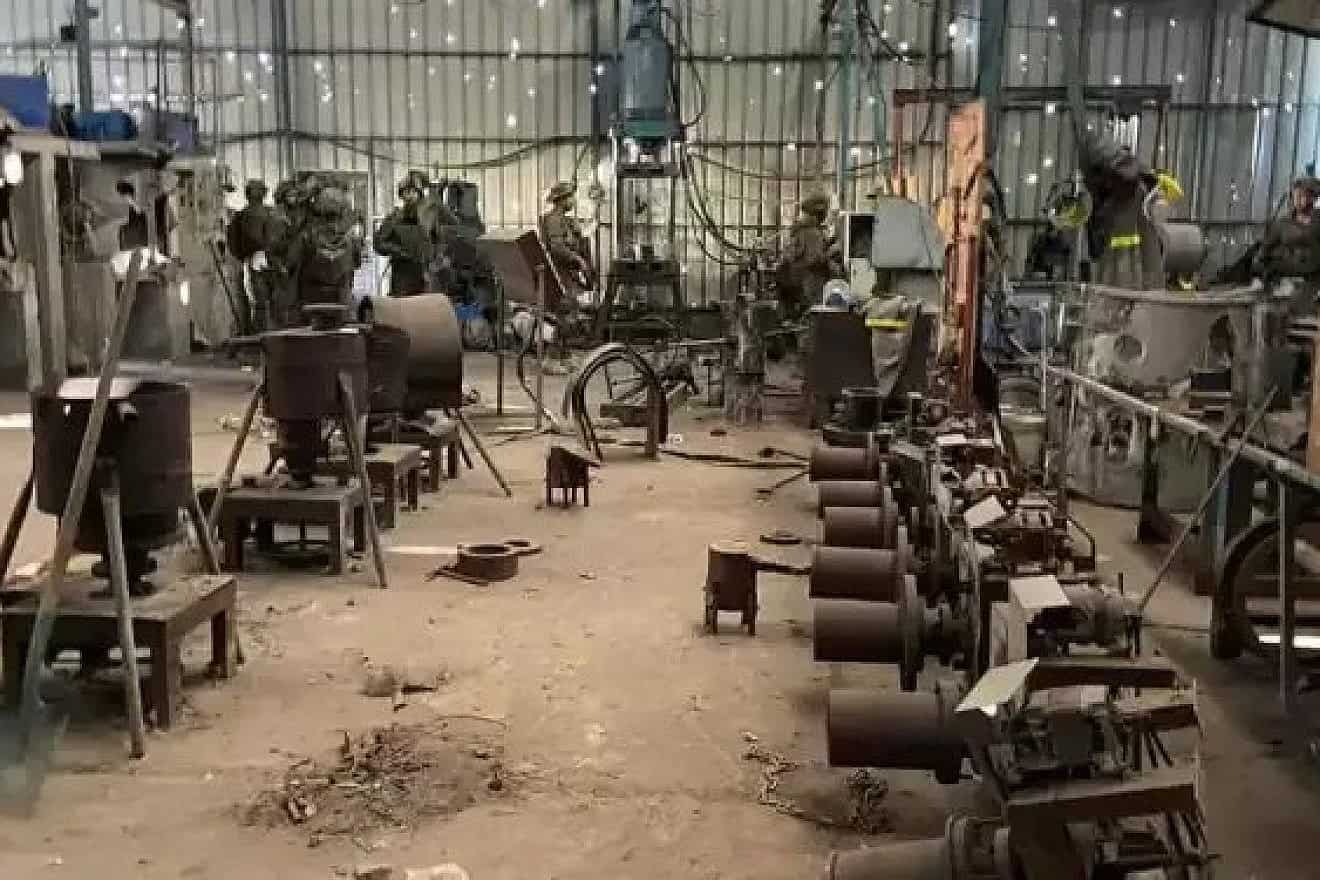It is easy to see that the dirt field and ruins located at the edge of the Al-Bureij refugee camp, in the heart of the Gaza Strip, was once a densely populated residential neighborhood. Here is a withered lawn; there a few chickens peck indifferently among armored vehicles.
But inside a small, unimpressive building, in the heart of a neighborhood normally teeming with civilians, fighters from the IDF’s 188th “Barak” Armored Brigade uncovered what was once a bustling munitions facility.
Inside the building, next to a comfortable, air-conditioned room, there was an entrance leading down into a tunnel dug about 100 feet deep. Entering the shaft causes immediate eye irritation due to the chemicals Hamas terrorists to produce large quantities of explosive material for rockets, mortar shells and IEDs.
“This was the commanders’ entrance,” says Col. Or Wolozhinsky as he displays the chemical protection suit used by the terrorists. “They would come every morning to this building, like workers to a regular office, drink coffee, cool off in the air conditioning, and then go below where they produced explosive material for missiles fired at Israel.”
Wolozhinsky explains that the location of the underground plant is no coincidence. “The facility was situated near Salah al-Din Road, a humanitarian corridor that Israel refrained from attacking during the fighting,” says the commander, as we pass by the tunnel entrance.
Missiles to northern Israel
Fighters from the 36th Division, guided by intelligence, succeeded in exposing the enormous scale of Hamas’s military industry in the central Gaza Strip refugee camp’s area in recent weeks. Inside the Al-Mawasi neighborhood, a Golani Brigade force exposed a missile production plant, meters away from Salah al-Din Road, where hundreds of thousands of Gazans passed on their way south.
Both the 188th Brigade and the Golani Brigade are part of the division.
In a large factory shed, the soldiers show dozens of industrial metal melting, molding and engraving machines. Large containers hold tens of thousands of unassembled mortar shells, with fuses nearby. At the far end of the shed, there is a large shaft with an elevator. Most production was done underground, where the finished products were readied for shipment.
In an adjacent structure are dozens of long-range missiles, capable of hitting northern Israel and nearly ready for use, lacking only warhead and paint. This building too has a huge shaft leading to an underground production space.
“The room below is huge. They only brought finished products above ground to transfer to the launch sites,” says Lt. Col. Ohad Moyal, commander of the Golani Reconnaissance Battalion.
The terrorists did not give up the expansive industrial complex easily.
“We saw hard fighting here. They counterattacked, blew up shafts, and set booby traps. Ultimately, they can’t stand against a force like ours over time, but they continued producing weapons up till the last moment, just as we were meters away from them,” says Moyal.
Other weapons factories were also found for the production of explosives, rocket guidance systems, mortar shells, small arms and drones.
“This is the largest weapons manufacturing site we have discovered since the beginning of the war,” IDF Spokesperson Rear Adm. Daniel Hagari said on Monday during his daily press briefing.
“This factory was connected to an underground tunnel system, through which weapons were transferred throughout the Gaza Strip. The rockets manufactured there were launched towards central Israel and other areas in the State of Israel. We will continue to operate against Hamas’s manufacturing infrastructure, against their underground system and Hamas leaders throughout the Gaza Strip,” he said.
A cursory examination of the compound shows why all of Israel’s air power did not suffice to paralyze Hamas’s industry of terror and death. Huge bomb craters gape on the grounds from IAF strikes preceding the ground offensive. But despite the heavy bombardment, which likely damaged infrastructures and even missile launch pits, nearby plants, in civilian buildings and underground, continued churning out thousands of mortar shells and rockets.
“Production at this facility could only be stopped as we did, on the ground, meter after meter, shed after shed,” says Moyal as we pass by a nearby blast crater.
The cruelty in Hamas’s design
Exiting one of the compound’s buildings, Salah al-Din Road is clearly visible. A civilian building situated right on the road was damaged in the fighting, with a hole breached in the wall. Through the hole, a clothing store is visible. Neat rows of hangars and dresses appear through the dusty air of the ruined refugee camp. In an adjacent building is the local headquarters of a cellphone company. The upper floors evidently served for residence.
The Hamas “Military Production” plant did not operate behind fences, but right in a neighborhood where civilians carried on daily life—chilling evidence of Hamas locating its factories of death amid the civilian population. The terrorist enterprise was deliberately placed next to civilian buildings to try to prevent harm to its facilities, or exact so heavy a civilian toll as to compel Israel to halt the operation.
This proximity between terrorist infrastructure and the local populace forced the IDF to operate meticulously and carefully, and the fear of terrorists remaining in shafts or explosives still detonating sometimes sends random spurts of gunfire echoing sporadically. Forces in the field have much work ahead to dismantle infrastructure so that it cannot serve Hamas again. It took Hamas years to build its subterranean plants and huge workshops, including the tunnel infrastructure connecting them.
Originally published by Israel Hayom.


























